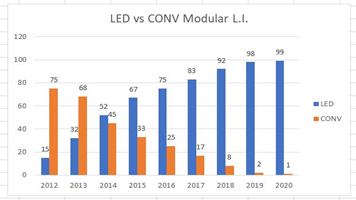Smart lighting
LED technology is not the only factor that supports us in benefiting from a reduction in energy consumption, however. The way the light is dimmed and controlled also plays a big part. Controlling luminaires in the right way, allows us to use the right amount of light, at the right place, at the right time of the day. All things considered, smart lighting can save another 8-12% on lighting installation energy consumption.
Traditional dimming systems (such as 1-10V or DALI) offer possibilities to integrate sensors in automation systems, while remaining valuable solutions to control lighting. These dimming systems can be easily integrated in broader building automation systems such as KNX.
In 2016, we partnered with Philips Hue to step into the smart lighting world. This enabled the connection of architectural lighting to the Internet of Things, in fact, pairing lighting to countless sensors, switches, voice control devices, app controls, programmable routines, and to controlling luminaires when not at home, etc.
Next to Philips Hue, we joined more connected lighting platforms such as Casambi and Niko Home Control, thus broadening our range of smart lighting even more.
